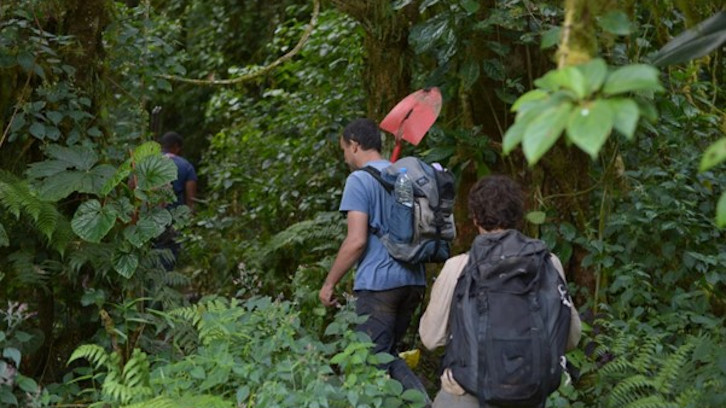Learning from small islands to understand Afromontane forests dynamics

An international group of researchers conducted a study on the island of São Tomé, Gulf of Guinea, to understand the dynamics of the Afromontane forests. Although these tropical forests withstood climatic changes 12,500 years ago, the introduction of plant species in the last 200 years and the increase in charcoal particles suggest their vulnerability to human impacts and global climate change.
The Afromontane forest is a rainforest ecosystem that grows above 800 m above sea level. It is known to store huge amounts of Carbon and to support many endemic species, while it is threatened by human activities and by climate change. One important aspect of these forests is that they are considered relics of glacial periods when they were more widespread across Africa. Thanks to palaeoecological data involving plant microfossils, it is also known that on African mountains they moved uphill during the Pleistocene-Holocene transition (15 to 10 thousand years ago). However, it was unclear if this uphill migration was a general pattern across Africa, namely on island forests, which have traditionally been considered buffered to climatic shifts.
To answer this question, our team, led by the University of La Laguna, Universitat Autònoma de Barcelona, and Lisbon University, carried out fieldwork on the small oceanic island of São Tomé, in the Gulf of Guinea. We obtained a 4.5-meter sedimentary sequence from Lagoa Amélia, located at 1340 m above sea level. Back in the laboratory, we extracted microfossils and charcoal particles from the sediments to identify the dynamics of trees, shrubs, ferns, grasses, and fires. After resolving the chronology of the sediments using radiocarbon dating, we identified major changes in the forest dynamics over the past 14,000 years, covering one of the last major rapid climatic changes in the northern hemisphere called the Younger Dryas, when the environment was cooler and dryer, and the onset of the Holocene, our current moist and warm interglacial epoch.
Our findings showed that the area around Lagoa Amélia remained forested, despite the uphill changes in the vegetation that occurred 12,500 years ago. This uphill migration was described for trees, such as Symphonia globulifera, Craterispermum cerinanthum, and Prunus africana, but also for climbers from the genus Sabicea. The forest response to climatic change aligns the natural history of this small island with that of continental Afromontane forests.
Yet, climatic-related changes were not the only drivers of change identified in our study. Therefore, we also identified the introduction of several plant species during the past 200 years, including cultivars such as Zea mays (maize), and invasives, such as Cestrum laevigatum and Rubus rosifolius. This coincides well with the known period of uphill human expansion on the island and is further supported by the increased record of charcoal particles in the sediments of Lagoa Amélia, since people used fire to clear forest and expand human activities to the São Tomé highlands. Therefore, these results suggest that these forests might be highly vulnerable not only to direct anthropogenic impacts but also to the ongoing global climate change.
Sandra Nogué
Center for Ecological Research and Forestry Applications (CREAF)
Universitat Autònoma de Barcelona
Ricardo Lima
Center for Ecology, Evolution and Environmental Changes (cE3c)
CHANGE – Global Change and Sustainability Institute
Gulf of Guinea Biodiversity Center (CBGG), São Tomé and Príncipe
Universidade de Lisboa
Alvaro Castilla-Beltrán
Archaeological Micromorphology and Biomarkers Research Laboratory, University Institute of Bio-Organic Antonio González
Island Ecology and Biogeography Group, University Institute of Tropical Diseases and Public Health of the Canary Islands
Universidad de La Laguna
References
Castilla-Beltrán, A., de Lima, R. F., Bosco, L. B., Armas, R. D. C., Strandberg, N., Stévart, T., Nascimento, L. D., María Fernández-Palacios, J. & Nogué, S. (2023). 14,000 years of climatic and anthropogenic change in the Afromontane forest of São Tomé Island, Gulf of Guinea. Quaternary Science Reviews, 322, 108381. https://doi.org/10.1016/j.quascirev.2023.108381

